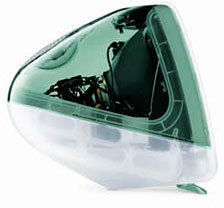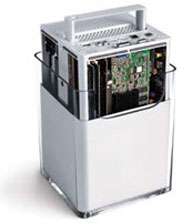July 2001 – Last week’s Macworld Expo was a disappointment for many people attending the show. People wanted to be amazed or surprised – flat screen iMacs were hoped for by many. The surprise was that the products were evolutionary.
![]()

 A speed-bumped iMac is an improvement – but not that big a change. iDVD 2 adds some new features, but the demo shows minor improvements from iDVD 1. Mac OS X 10.1 Puma adds a lot of performance, but it’s really just catching up with what people had hoped 10.0 would be. The Quicksilver Power Macs are a nice refinement but don’t drastically change the Mac landscape.
A speed-bumped iMac is an improvement – but not that big a change. iDVD 2 adds some new features, but the demo shows minor improvements from iDVD 1. Mac OS X 10.1 Puma adds a lot of performance, but it’s really just catching up with what people had hoped 10.0 would be. The Quicksilver Power Macs are a nice refinement but don’t drastically change the Mac landscape.
Ah, excitement. Sure, it’s neat to get shocked by a new product. I think we are missing the point: Real revolutions are rarely announced. Put it another way: Most “revolutions” are merely attempts to engage us as consumers and convince us to open our wallets. I think that revolutions cannot be watched – for something to be a revolution, you need to participate.
Let me give a few examples on both sides. This week, let’s look at a few revolutionary products and see why they don’t live up to the hype. Next week we can look at rather humdrum products that can be life-changing.
The Revolutionary Power Mac G4 Cube
 The poster-child for a revolutionary product is the G4 Cube. It was something different and unique that we had never seen before.
The poster-child for a revolutionary product is the G4 Cube. It was something different and unique that we had never seen before.
Don’t get me wrong: It is a cool computer. The first time I played around with one, I felt as if I could be in the ready room of the Starship Enterprise.
The revolution never arrived, though. People did not start buying Cubes to be used in all the places where aesthetics matter. Businesses didn’t buy Cubes for their receptionists. Families didn’t buy Cubes so they could have an elegant computer in their living room.
Without participation by consumers, the Cube was computer without a niche.
The Revolutionary PowerPC
Back in 1994, everyone was talking about the revolutionary PowerPC chip. Nearly overnight Apple became the largest producer of RISC-based computers. (A current parallel: Nearly overnight this year, Apple will become the largest producer of Unix-based computers with Mac OS X.) The RISC processor was supposed to make Macs much faster.
The real-world experience of the PowerPC (PPC) was drastically different. The top of the line Power Mac 8100/80 was actually slower than a Quadra at many tasks, because existing software needed to run in emulation. If Apple had gone with the 50 MHz Motorola 68060, the 1994 Macs would have been faster.
Over time, developers made PPC-native software, but the speed increases were minor compared to the theoretical increases you might have expected based on the hardware specifications. The PowerPC revolution was a myth.
Much of the Mac OS was written in 68k code that required emulation by PPC chips. In Mac OS 8, for example, the most obvious change was the Appearance extension that provided the platinum interface that was the Mac standard for four years. The Appearance extension was written in 68k code even though Mac OS 8 was released several years after the first Power Macs.* The Appearance extension improves the interface of the Mac, but it does so by putting an unnecessary drag on the processor. So even while programs became “Accelerated for PowerPC”, core parts of the operating system continued to hinder performance.
The PowerPC was a new processor that had such large architectural advantages that it was expected to destroy x86 processors like Intel’s Pentium. The PPC was faster, less expensive, and used less energy. But the 68k emulation in the Mac OS reduced the speed advantage. PowerPCs remain much less expensive than Pentiums, but that is irrelevant to consumers when Macs cost more than PCs.
Nowadays the energy efficiency of the PowerPC is the main advantage. It allows Apple to design fanless iMacs, since the G3 uses a fraction of the power of Pentium.
The announcements of the Cube and the PowerPC were exciting, but if you thought that they would change your life or make you a happier person, you would probably be mistaken.
Next week we’ll discuss how something as boring as a database can be truly revolutionary – if you are willing to participate in the revolution.
* Because Mac OS 8 still supported the 68040, the Appearance extension had to have 68k code. However, it could have been created as a “FAT binary” to improved PowerPC performance.
Short link: http://goo.gl/uh9KlB
searchword: revolutionparticipation

